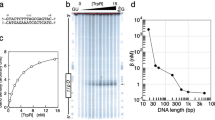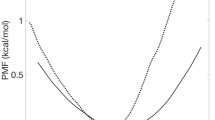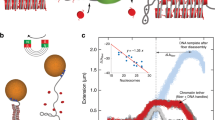Abstract
THE Escherichia coli phage 434 represser binds as a dimer to the operator of the DNA helix. Although the centre of the operator is not in contact with protein, the represser binding affinity can be reduced at least 50-fold by changing the sequence there1: operators with A·T base pairs near their centre bind the represser more strongly than do operators with G·C base pairs at the same positions. To explain these observations, it has been proposed that the base composition at the centre of the operator affects the affinity of the operator for represser by altering the ease with which operator DNA can undergo the torsional deformation necessary for complex formation 1,2. In this model, the variation in binding affinity would require the torsion constant to have specific values and to change in a sequence-dependent manner1. We have now measured torsion constants for DNAs with widely different base compositions. Our results indicate that the torsion constants depend only slightly on the overall composition, and firmly delimit the range of values for each. Even the upper-limit values are much too small to account for the observed changes in affinity of the 434 represser. These results rule out simple models that rely on substantial generic differences in torsion constant between A·T-rich sequences and G·C-rich sequences, although they do not rule out the possibility of particular sequences having abnormal torsion constants.
This is a preview of subscription content, access via your institution
Access options
Subscribe to this journal
Receive 51 print issues and online access
$199.00 per year
only $3.90 per issue
Buy this article
- Purchase on Springer Link
- Instant access to full article PDF
Prices may be subject to local taxes which are calculated during checkout
Similar content being viewed by others
References
Koudelka, G. B., Harbury, P., Harrison, S. C. & Ptashne, M. Proc. natn. Acad. Sci. U.S.A. 85, 4633–4637 (1988).
Hogan, M. E. & Austin, R. H. Nature 329, 263–266.
Schurr, J. M. Chem. Phys. 84, 71–96 (1984).
Allison, S. A. & Schurr, J. M. Chem. Phys. 41, 35–59 (1979).
Thomas, J. C., Allison, S. A., Appellof, C. J. & Schurr, J. M. Biophys. Chem. 12, 177–188 (1980).
Thomas, J. C. & Schurr, J. M. Biochemistry 22, 6194–6198 (1983).
Shibata, J. H., Wilcoxon, J., Schurr, J. M. & Knauf, V. Biochemistry 23, 1188–1194 (1984).
Fujimoto, B. S., Shibata, J. H., Schurr, R. L. & Schurr, J. M. Biopolymers 24, 1009–1022 (1985).
Wu, P. et al. Biochemistry 27, 8128–8144 (1988).
Schurr, J. M., Fujimoto, B. S., Wu, P. & Song, L. in Applications of Fluorescence Spectroscopy (ed. Lakowicz, J. R.) ( in the press).
Shibata, J. H., Fujimoto, B. S. & Schurr, J. M. Biopolymers 24, 1909–1930 (1985).
Song, L. & Schurr, J. M. Biopolymers (in the press).
Taylor, W. H. & Hagerman, p. J. J. molec. Biol. (in the press).
Waring, M. J. J. Molec. Biol. 13, 783–801 (1965).
Le Pecq, J. B. & Paoletti, C. J. molec. Biol. 27, 87–106 (1967).
Müller, W. & Crothers, D. M. Eur. J. Biochem. 54, 267–277 (1975).
Nelson, J. W. & Tinoco, I. Jr Biopolymers 23, 213–233 (1984).
Wu, P., Fujimoto, B. S. Song, L. & Schurr, J. M. Biophys. Chem. (manuscript submitted).
Millar, D. P., Robbins, R. J. & Zewail, A. H. J. chem. Phys. 76, 2080–2094 (1982).
Ashikawa, I., Kinosita, K. Jr. & Ikegami, A. Biochim biophys. Acta 789, 87–93 (1984).
Hogan, M., Wang, J., Austin, R. H., Monitto, C. L. & Hershkowitz, S. Proc. natn. Acad. Sci. U.S.A. 79, 3518–3522 (1982).
Hogan, M., LeGrange, J. & Austin, R. H. Nature 304, 752–754 (1983).
Anderson, J. E., Ptashne, M. & Harrison, S. C. Nature 326, 888–891 (1987).
Koudelka, G. B., Harrison, S. C. & Ptashne, M. Nature 326, 886–888 (1987).
Thomas, T. J. & Bloomfield, V. A. Nucleic. Acids Res. 11, 1919–1930 (1983).
Chen, H. H., Rau, D. C. & Charney, D. C. J. biomolec. Struct. Dyn. 2, 709–719 (1985).
Wu, H.-M. & Crothers, D. M. Nature 308, 509–513 (1984).
Liu-Johnson, H.-N., Gartenberg, M. R. & Crothers, D. M. Cell 47, 995–1005 (1986).
Allison, S. A., Austin, R. H. & Hogan, M. E. J. chem. Phys. 90, 3845–3854 (1989).
Barkley, M. D. & Zimm, B. H. J. chem. Phys. 70, 2991–3007 (1979).
Song, L. & Schurr, J. M. Biopolymers (in the press).
Diekmann, S., Hillen, W., Morgenmeyer, B., Wells, R. D. & Pörschke, D. Biophys. Chem. 15, 263–270 (1982).
Pörschke, D., Zacharias, W. & Wells, R. D. Biopolymers 26, 1971–1974 (1987).
Author information
Authors and Affiliations
Rights and permissions
About this article
Cite this article
Fujimoto, B., Schurr, J. Dependence of the torsional rigidity of DNA on base composition. Nature 344, 175–178 (1990). https://doi.org/10.1038/344175a0
Received:
Accepted:
Issue Date:
DOI: https://doi.org/10.1038/344175a0
This article is cited by
-
Freely orbiting magnetic tweezers to directly monitor changes in the twist of nucleic acids
Nature Communications (2011)
-
Magnetic torque tweezers: measuring torsional stiffness in DNA and RecA-DNA filaments
Nature Methods (2010)
-
Fine mapping of inherent flexibility variation along DNA molecules. Validation by atomic force microscopy (AFM) in buffer
Molecular Genetics and Genomics (2005)
-
DNA twisting and the effects of non-contacted bases on affinity of 434 operator for 434 represser
Nature (1992)
Comments
By submitting a comment you agree to abide by our Terms and Community Guidelines. If you find something abusive or that does not comply with our terms or guidelines please flag it as inappropriate.



